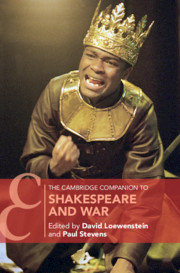Book contents
- The Cambridge Companion to Shakespeare and War
- The Cambridge Companion to Shakespeare and War
- Copyright page
- Dedication
- Contents
- Figures
- Contributors
- Preface
- Acknowledgments
- 1 Beyond Shallow and Silence
- 2 Just War Theory and Shakespeare
- 3 Shakespeare on Civil and Dynastic Wars
- 4 Foreign War
- 5 War and the Classical World
- 6 “The Question of These Wars”
- 7 Instrumentalizing Anger
- 8 War and Eros
- 9 Shakespeare’s Language and the Rhetoric of War
- 10 Staging Shakespeare’s Wars in the Twentieth and Twenty-First Centuries
- 11 Reading Shakespeare’s Wars on Film
- 12 Shakespeare and World War II
- 13 Henry V and the Pleasures of War
- 14 Macbeth and Trauma
- 15 Coriolanus and the Use of Power
- Index
- References
10 - Staging Shakespeare’s Wars in the Twentieth and Twenty-First Centuries
Published online by Cambridge University Press: 17 August 2021
- The Cambridge Companion to Shakespeare and War
- The Cambridge Companion to Shakespeare and War
- Copyright page
- Dedication
- Contents
- Figures
- Contributors
- Preface
- Acknowledgments
- 1 Beyond Shallow and Silence
- 2 Just War Theory and Shakespeare
- 3 Shakespeare on Civil and Dynastic Wars
- 4 Foreign War
- 5 War and the Classical World
- 6 “The Question of These Wars”
- 7 Instrumentalizing Anger
- 8 War and Eros
- 9 Shakespeare’s Language and the Rhetoric of War
- 10 Staging Shakespeare’s Wars in the Twentieth and Twenty-First Centuries
- 11 Reading Shakespeare’s Wars on Film
- 12 Shakespeare and World War II
- 13 Henry V and the Pleasures of War
- 14 Macbeth and Trauma
- 15 Coriolanus and the Use of Power
- Index
- References
Summary
This chapter analyzes traditions of staging the plays from the beginning of the twentieth century, spanning a period from the Boer Wars until the postcolonial wars of the present. It considers not only ways of depicting fighting and battles, but also perspectives on the morality of war created by Shakespeare and his directors. During this period, post-Victorian pictorial realism and historical “accuracy” survived in cinema, but in the theater they gave way to non-illusionistic and unlocalized sets as companies turned their attention from “history” to politics. This did not mean that spectacle diminished: shocking savagery and violence could be graphically represented, but pageants of royal and aristocratic grandeur along with appeals to patriotism sustained by providence were set against vignettes of common life – no longer “comic relief” but ironic touchstones that detected processes of chauvinism, huffing rhetoric, and heroic posturing as families, factions, and nations tore themselves apart.
- Type
- Chapter
- Information
- The Cambridge Companion to Shakespeare and War , pp. 167 - 186Publisher: Cambridge University PressPrint publication year: 2021



